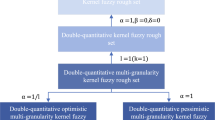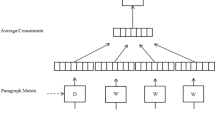Abstract
Searching for quantitative scientific prediction models and methods under uncertain hybrid information environment is helpful to the scientific decision-making of practical management problems. In this paper, we discuss the uncertain decision making problem with hybrid attributes and fuzzy decision objects. Considering the characteristic of hybrid attribute information, we introduce kernel functions to abstract the similarities from different types of attributes. On this basis, the kernel-based upper and lower approximations of arbitrary fuzzy decision objects over hybrid attribute information system are given under a multi-granularity framework, i.e., kernelized multi-granulation fuzzy rough sets, called KMGFRS in this paper. Then, the attribute reduction on hybrid attribute decision system based on KMGFRS is discussed. In addition, we combine KMGFRS and fuzzy k-nearest neighbors (FkNN) to propose a new prediction method without prior information and apply it to stroke risk assessment and prediction in clinical decision-making. Finally, we use real clinical data and UCI datasets for experiment analysis, and the results verify the applicability and validity of the model.




Similar content being viewed by others
Explore related subjects
Discover the latest articles, news and stories from top researchers in related subjects.References
Ba J, Liu K, Ju H, Xu S, Xu T, Yang X (2022) Triple-g: a new mgrs and attribute reduction. Int J Mach Learn Cybern 13(2):337–356
Bai J, Sun B, Chu X, Wang T, Li H, Huang Q (2022) Neighborhood rough set-based multi-attribute prediction approach and its application of gout patients. Appl Soft Comput 114:108127
Balaji VR, Suganthi ST, Rajadevi R, Krishna Kumar V, Saravana Balaji B, Pandiyan S (2020) Skin disease detection and segmentation using dynamic graph cut algorithm and classification through naive bayes classifier. Meas 15(163):107922
Chen J, Lin Y, Mi J, Li S, Ding W (2021) A spectral feature selection approach with kernelized fuzzy rough sets. IEEE Trans Fuzzy Syst 30(8):2886–2901
Cover T, Hart P (1967) Nearest neighbor pattern classification. IEEE Trans Infor Theor 13(1):21–27
Derrac J, Chiclana F, García S, Herrera F (2016) Evolutionary fuzzy k-nearest neighbors algorithm using interval-valued fuzzy sets. Inf Sci 329:144–163
Dubois D, Prade H (1990) Rough fuzzy sets and fuzzy rough sets. Int J Gen Syst 17:191–209
Ezghari S, Zahi A, Zenkouar K (2017) A new nearest neighbor classification method based on fuzzy set theory and aggregation operators. Exp Syst Appl 80:58–74
Fujita H, Gaeta A, Loia V, Orciuoli F (2019) Resilience analysis of critical infrastructures: a cognitive approach based on granular computing. IEEE trans Cybern 49(5):1835–1848
Fujita H, Gaeta A, Loia V, Orciuoli F (2020) Hypotheses analysis and assessment in counterterrorism activities: A method based on owa and fuzzy probabilistic rough sets. IEEE Trans Fuzzy Syst 28(5):831–845
Goreke V, Sari V, Kockanat S (2021) A novel classifier architecture based on deep neural network for covid-19 detection using laboratory findings. Appl Soft Comput 106:107329
Gu D, Su K, Zhao H (2020) A case-based ensemble learning system for explainable breast cancer recurrence prediction. Artif Intell Med 107:101858
Hu Q, Yu D, Liu J, Wu C (2008) Neighborhood rough set based heterogeneous feature subset selection. Inf Sci 178(18):3577–3594
Hu Q, Yu D, Liu J, Wu C (2008) Neighborhood rough set based heterogeneous feature subset selection. Inf Sci 178(18):3577–3594
Hu Q, Yu D, Pedrycz W, Chen D (2011) Kernelized fuzzy rough sets and their applications. IEEE Trans Knowl Data Eng 23(11):1649–1667
Hu Q, Zhang L, An S, Zhang D, Yu D (2012) On robust fuzzy rough set models. IEEE Trans Fuzzy Syst 20(4):636–651
Hu Q, Zhang L, Zhou Y, Pedrycz W (2018) Large-scale multimodality attribute reduction with multi-kernel fuzzy rough sets. IEEE Trans Fuzzy Syst 26(1):226–238
Johnson CO, Nguyen M (2019) Global, regional, and national burden of stroke, 1990–2016: a systematic analysis for the global burden of disease study 2016. Lancet Neurol 18(5):439–458
Ju H, Ding W, Yang X, Fujita H, Xu S (2021) Robust supervised rough granular description model with the principle of justifiable granularity. Appl Soft Comput 110:107612
Keller JM, Gray MR, Givens JA (1985) A fuzzy k-nearest neighbor algorithm. IEEE Trans Syst Man Cybern 4:580–585
Li J, Ren Y, Mei C, Qian Y, Yang X (2016) A comparative study of multigranulation rough sets and concept lattices via rule acquisition. Knowl-Based Syst 91:152–164
Li W, Xu W, Zhang X, Zhang J (2022) Updating approximations with dynamic objects based on local multigranulation rough sets in ordered information systems. Artif Intell Rev 55(3):1821–1855
Li Y, Lin Y, Liu J, Weng W, Shi Z, Wu S (2018) Feature selection for multi-label learning based on kernelized fuzzy rough sets. Neurocomput 318:271–286
Liang P, Lei D, Chin K, Hu J (2022) Feature selection based on robust fuzzy rough sets using kernel-based similarity and relative classification uncertainty measures. Knowl-Based Syst 255:109795
Liu K, Yang X, Fujita H, Liu D, Yang X, Qian Y (2019) An efficient selector for multi-granularity attribute reduction. Inf Sci 505:457–472
Ma X (2020) Measures associated with granularity and rough approximations in interval-valued information tables based on kernel similarity relations. Inf Sci 538:337–357
Moser B (2006) On representing and generating kernels by fuzzy equivalence relations. J Mach Learn Res 7(Dec):2603–2620
Pawlak Z (1982) Rough sets. Int J Comput Inf Sci 11(5):341–356
Pedrycz W (2018) Granular computing: analysis and design of intelligent systems. CRC Press
Qian Y, Liang J, Yao Y, Dang C (2010) Mgrs: A multi-granulation rough set. Inf Sci 180(6):949–970
Sun B, Chen X, Zhang L, Ma W (2020) Three-way decision making approach to conflict analysis and resolution using probabilistic rough set over two universes. Inf Sci 507:809–822
Sun B, Tong S, Ma W, Wang T, Jiang C (2022) An approach to mcgdm based on multi-granulation pythagorean fuzzy rough set over two universes and its application to medical decision problem. Artif Intell Rev 55(3):1887–1913
Sun L, Yin T, Ding W, Qian Y, Xu J (2021) Feature selection with missing labels using multilabel fuzzy neighborhood rough sets and maximum relevance minimum redundancy. IEEE Trans Fuzzy Syst 30(5):1197–1211
Sun L, Wang T, Ding W, Xu J (2022) Partial multilabel learning using fuzzy neighbourhood-based ball clustering and kernel extreme learning machine. IEEE Transactions on Fuzzy Systems
Sun L, Si S, Ding W, Wang X, Xu J (2023) Tfsfb: Two-stage feature selection via fusing fuzzy multi-neighborhood rough set with binary whale optimization for imbalanced data. Inf Fusion 95:91–108
Wan Q, Li J, Wei L (2021) Optimal granule combination selection based on multi-granularity triadic concept analysis. Cognit Comput 14:1844–1858
Wang C, Hu Q, Wang X, Chen D, Qian Y, Dong Z (2018) Feature selection based on neighborhood discrimination index. IEEE Trans Neural Netw Learn Syst 29(7):2986–2999
Wang C, Huang Y, Shao M, Fan X (2019) Fuzzy rough set-based attribute reduction using distance measures. Knowl-Based Syst 164:205–212
Witten IH, Frank E, Hall MA (2005) Practical machine learning tools and techniques. Morgan Kaufmann p 578
Wu J, Dai L, Chiclana F, Fujita H, Herrera-Viedma E (2018) A minimum adjustment cost feedback mechanism based consensus model for group decision making under social network with distributed linguistic trust. Inf Fusion 41:232–242
Xu W, Yuan K, Li W (2022) Dynamic updating approximations of local generalized multigranulation neighborhood rough set. Appl Intell 52:9148–9137
Xu Z (2005) Deviation measures of linguistic preference relations in group decision making. Omega 33(3):249–254
Yang H, Chen L, Cheng Z, Yang M, Wang J, Lin C, Wang Y, Huang L, Chen Y, Peng S, Ke Z, Li W (2021) Deep learning-based six-type classifier for lung cancer and mimics from histopathological whole slide images: a retrospective study. BMC Med 19(1):80
Yao Y (2008) Probabilistic rough set approximations. International journal of approximate reasoning 49(2):255–271
Ye J, Sun B, Zhan J, Chu X (2022) Variable precision multi-granulation composite rough sets with multi-decision and their applications to medical diagnosis. Inf Sci 615:293–322
Yuan Z, Chen H, Yang X, Li T, Liu K (2021) Fuzzy complementary entropy using hybrid-kernel function and its unsupervised attribute reduction. Knowl-Based Syst 231:107398
Zeng A, Li T, Liu D, Zhang J, Chen H (2015) A fuzzy rough set approach for incremental feature selection on hybrid information systems. Fuzzy Sets Syst 258:39–60
Zhan J, Deng J, Xu Z, Martínez L (2023) A three-way decision methodology with regret theory via triangular fuzzy numbers in incomplete multi-scale decision information systems. IEEE Transactions on Fuzzy Systems. https://doi.org/10.1109/TFUZZ.2023.3237646
Zhan J, Wang J, Ding W, Yao Y (2023) Three-way behavioral decision making with hesitant fuzzy information systems: Survey and challenges. IEEE/CAA J Autom Sin 10(2):330–350
Zhang J, Li T, Chen H (2014) Composite rough sets for dynamic data mining. Inf Sci 257:81–100
Zhang P, Li T, Wang G, Wang D, Lai P, Zhang F (2023) A multi-source information fusion model for outlier detection. Inf Fusion 93:192–208
Zhu J, Ma X, Martínez L, Zhan J (2023) A probabilistic linguistic three-way decision method with regret theory via fuzzy c-means clustering algorithm. IEEE Transactions on Fuzzy Systems. https://doi.org/10.1109/TFUZZ.2023.3236386
Acknowledgements
The work was partly supported by the National Natural ScienceFoundation of China (No. 72071152) the Shaanxi Outstanding Youth Fund Project (2023-JC-JO-11), the Youth InnovationTeam of Shaanxi Universities (2019), the Xi’an Science and Technology Projects (22RKYJ0030), the Fundamental Research Funds for the Central Universities, China (20101236618,20101236262), the Guangzhou Key Research and Development Program (202206010101)and the Guangdong Basic and Applied Basic Research Foundation(2022A1515110703), the Major scientific research project of the "Buchang Cup" Brain-Heart Collaborative Research Fund in 2022 (NXTZ20221101), the Xi’an Science and Technology Support Project (22YXYJ0096), the National Science Foundation Incubation Program of the Second Affiliated Hospital of Xi’an Medical University(23KY0101), the Project of Shaanxi Key Laboratory of BrainDisorders (No.20NBZD02).
Author information
Authors and Affiliations
Corresponding author
Ethics declarations
Conflict of Interest
The authors declare that they have no conflict of interest.
Additional information
Publisher's Note
Springer Nature remains neutral with regard to jurisdictional claims in published maps and institutional affiliations.
Rights and permissions
Springer Nature or its licensor (e.g. a society or other partner) holds exclusive rights to this article under a publishing agreement with the author(s) or other rightsholder(s); author self-archiving of the accepted manuscript version of this article is solely governed by the terms of such publishing agreement and applicable law.
About this article
Cite this article
Wang, T., Sun, B. & Jiang, C. Kernelized multi-granulation fuzzy rough set over hybrid attribute decision system and application to stroke risk prediction. Appl Intell 53, 24876–24894 (2023). https://doi.org/10.1007/s10489-023-04850-8
Accepted:
Published:
Issue Date:
DOI: https://doi.org/10.1007/s10489-023-04850-8




